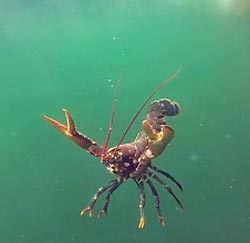Wind parks at sea offering a new home to lobsters?

Lobster under water<br>Photo: Uwe Nettelmann, Alfred Wegener Institute<br>
The Land of Lower Saxony is promoting a pilot project on the settlement of the European lobster in the “Riffgat“ offshore windpark with just under EUR 700,000. Researchers of the Alfred Wegener Institute, Helmholtz Centre for Polar and Marine Research, are now starting on the rearing of 3,000 lobsters which they will be releasing in 2014. They wish to investigate whether lobsters successfully settle between the wind turbines.
New structures are created on the bottom of the North Sea with the construction of the windpark. Sand and silt soils dominate the bed in the German Bight; wind turbines are offering other ecosystems a new settlement area in the form of so-called hard substrate. One example of a rocky bed dweller is the European lobster which hides in crevices during the day and becomes active at night. Researchers at the Biological Institute Heligoland, which belongs to the Alfred Wegener Institute (AWI), Helmholtz Centre for Polar and Marine Research, wish to place lobsters in this newly created habitat.
The Land of Lower Saxony, represented by the NLWKN (Lower Saxony Institute for Water Management, Coastal Protection and Nature Conservation), is funding the three-year pilot project ”Lobster settlement in the Riffgat windpark“ with just under EUR 700,000. The money comes from the compensation payments under nature conservation law for the „Riffgat“ windpark. An agreement has been concluded between the NLWKN and the AWI to use this funding. The project is intended to investigate the basic possibility of and the conditions for and ecological consequences of a lobster settlement of this kind.
“Whilst the large number of windparks which will be developed in the German Bight in the next 15 years represent an encroachment on the ecosystem, they could also be combined with measures of ecological enhancement“, says Prof. Dr. Heinz-Dieter Franke, AWI biologist on Heligoland. The closure of the windparks to industrial fishing created an urgently needed area of protection and recuperation for fish and invertebrate sea bed fauna. The inhabitants of hard beds threatened with extinction could also be given additional habitat. This also applied to the population of the European lobster in the German Bight which is essentially restricted to the rocky area around the Island of Heligoland. “Despite protective measures. the lobster population has not recovered from a strong decline in the fifties and sixties to this very day “, explains Franke. A successful settlement of the animals in the rocky fields surrounding the individual windparks as scour protection could contribute to a long-term stabilisation of the population.
The work is being conducted in close cooperation with the operator Offshore-Windpark RIFFGAT GmbH & Co. KG, Oldenburg (a merger of the energy provider EWE and the ENOVA Group) and the project partners datadiving GmbH with the scientific diver Dr. Roland Krone. AWI scientist Dr. Isabel Schmalenbach will be rearing 3,000 animals in a station on Heligoland next year. Once the young lobsters have reached a length of around ten centimetres, the researcher, working together with divers from datadiving GmbH, will release them into the windpark. In the coming years Schmalenbach and Krone will be investigating the lobster settlement grounds and a reference area to determine how many of the young animals have become successfully established in the stony grounds, whether they remain here or seek out a crevice in a neighbouring area, how accompanying fauna (large crabs and fish) develop and whether wild lobsters migrate into the area. The project is based on the many years of experience with rearing and release programmes for young lobsters on Heligoland.
Notes for Editors:
Printable images are available at http://www.awi.de/en/news/press_releases/.
Your contact partners are Prof. Dr. Heinz-Dieter Franke (phone +49 4725 819-3346; e-mail: Heinz-Dieter.Franke(at)awi.de) and Dr. Isabel Schmalenbach (phone +49 4725 819-3342; e-mail: Isabel.Schmalenbach(at)awi.de). Your contact partner in the Communications and Media Department is Dr. Folke Mehrtens (phone +49 471 4831-2007, e-mail: Folke.Mehrtens(at)awi.de).
Follow the Alfred Wegener Institute on Twitter and Facebook for all current news and information on everyday stories from the life of the Institute.
The Alfred Wegener Institute conducts research in the Arctic and Antarctic and in the high and mid-latitude oceans. The Institute coordinates German polar research and provides important infrastructure such as the research ice breaker Polarstern and stations in the Arctic and Antarctic to the international scientific world. The Alfred Wegener Institute is one of the 18 research centres of the Helmholtz Association, the largest scientific organisation in Germany.
Media Contact
More Information:
http://www.awi.deAll latest news from the category: Ecology, The Environment and Conservation
This complex theme deals primarily with interactions between organisms and the environmental factors that impact them, but to a greater extent between individual inanimate environmental factors.
innovations-report offers informative reports and articles on topics such as climate protection, landscape conservation, ecological systems, wildlife and nature parks and ecosystem efficiency and balance.
Newest articles

Silicon Carbide Innovation Alliance to drive industrial-scale semiconductor work
Known for its ability to withstand extreme environments and high voltages, silicon carbide (SiC) is a semiconducting material made up of silicon and carbon atoms arranged into crystals that is…

New SPECT/CT technique shows impressive biomarker identification
…offers increased access for prostate cancer patients. A novel SPECT/CT acquisition method can accurately detect radiopharmaceutical biodistribution in a convenient manner for prostate cancer patients, opening the door for more…

How 3D printers can give robots a soft touch
Soft skin coverings and touch sensors have emerged as a promising feature for robots that are both safer and more intuitive for human interaction, but they are expensive and difficult…





















